In the central African rainforests, there is a secretive animal called the okapi. The okapi, easily identified by its zebra-like patterns, is more connected to the giraffe than to the zebra.
Outside of its limited natural area, the okapi is not an especially well-known mammal. Most okapis remain concealed in jungles and are only seldom spotted by people; about 100 are housed in zoos around the world.
Keep reading to learn fascinating facts about okapis.
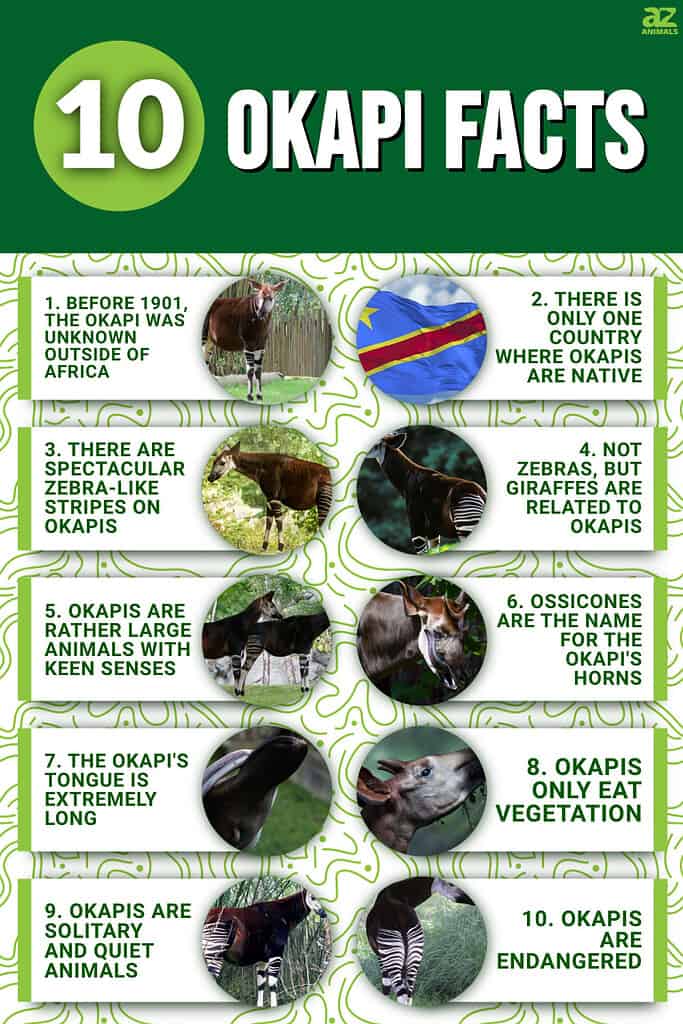
1. Before 1901, the Okapi was Unknown Outside of Africa
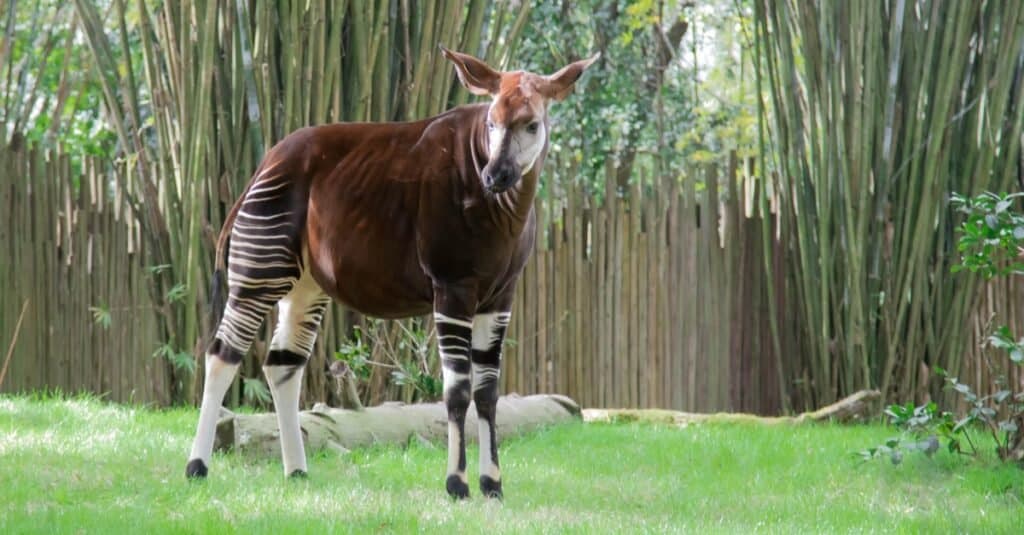
Okapis are natives of Africa, and their existence was only known to that part of the world.
©seth miles/Shutterstock.com
Okapis are natives of Africa, and their existence was only known to that part of the world. But Sir Harry H. Johnston, a British explorer and botanist, identified the species as a new species for the first time in 1901.
Today, okapis are referred to by their scientific name, Okapia johnstoni. The word “okapi” is derived from the indigenous term for the animal, “o’api.” However, Sir Harry H. Johnston is credited with the okapi’s scientific name’s second component. He obtained okapi skin and skull samples and established the species’ existence. This made it possible for researchers to classify the okapi as a separate species.
The okapi is still hard to find. It wasn’t until 2008 that the first image of an okapi in the wild was taken by a camera trap put up by the Zoological Society of London.
2. There is Only One Country Where Okapis are Native

©iStock.com/vistoff
Only the Democratic Republic of the Congo (DRC) is home to okapis. They are therefore indigenous to the Democratic Republic of the Congo. Okapis once lived in Uganda, but they are now extinct there.
The DRC is the second-largest country in Africa and is situated in the middle of the continent. It is reputed to be the African nation with the most biological diversity.
The northern parts of the nation are home to the majority of okapis. A sizable portion of the world’s okapi population lives in the Ituri Forest in northeastern DRC. One-fifth of the Ituri Forest is made up of the Okapi Wildlife Reserve. Okapis inhabit places with tropical rainforests. They are solitary creatures who favor densely wooded regions. Okapis typically stay away from populated areas.
3. There are Spectacular Zebra-Like Stripes on Okapis
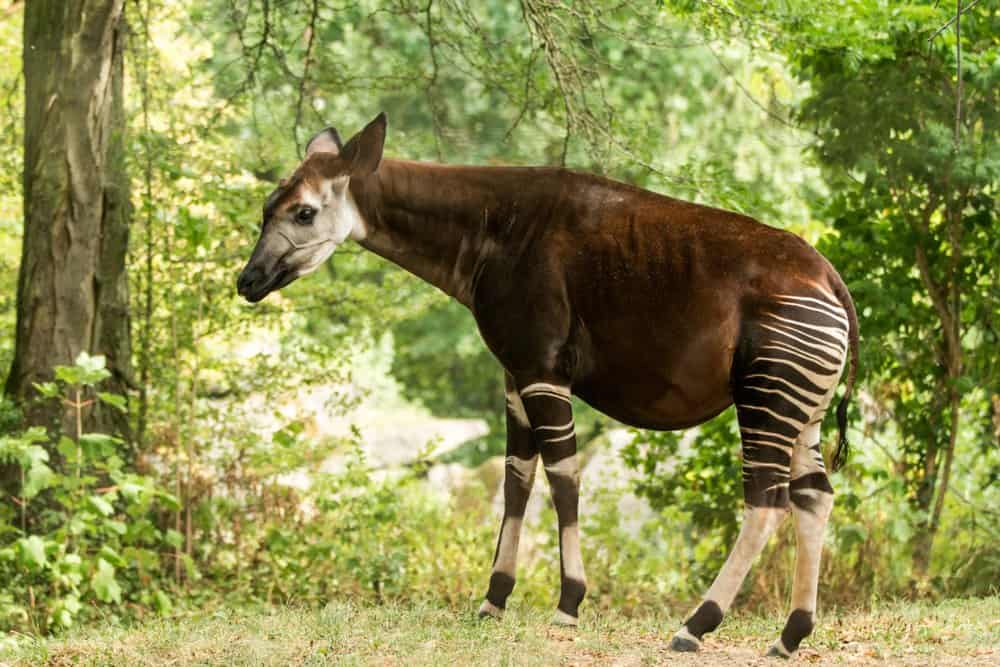
Okapis’ hindquarters and front legs have black and white “zebra” stripes.
©Jiri Hrebicek/Shutterstock.com
The bright colors of an okapi’s coat are the first thing you’ll notice about it if you are lucky enough to see one. Its hindquarters and front legs have black and white “zebra” stripes. Except for its white face, the remainder of its body is a vivid plum color. An okapi’s stripes on its legs offer excellent camouflage.
Okapis reside in dense rainforests where they blend in astonishingly well with the dark areas and filtered sunlight, in contrast to giraffes which typically browse in more open settings.
The stripes might potentially have an additional, seemingly incongruous function in addition to concealment. Because they are considered to aid young okapis in seeing and following their mothers through the undergrowth, okapi stripes are sometimes referred to as “follow me” stripes. Additionally, since each individual’s stripe pattern is distinctive, they might potentially aid with okapi identification.
4. Not Zebras, but Giraffes are Related to Okapis
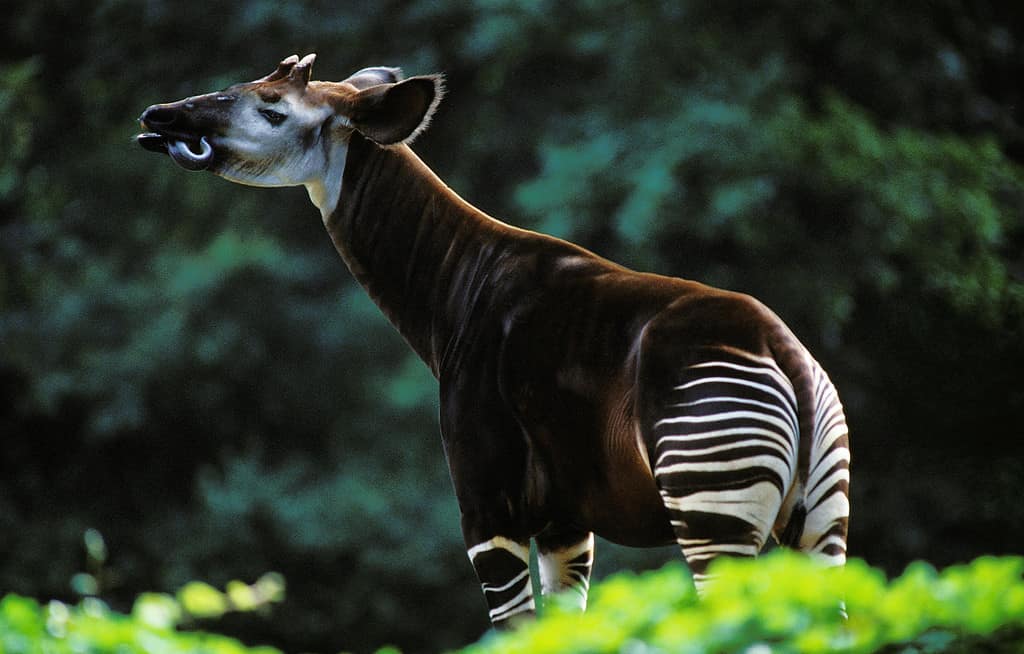
The only surviving giraffe family members who aren’t giraffes are okapis.
©slowmotiongli/ via Getty Images
It makes sense to believe okapis are related to zebras at first appearance. After all, they have leg stripes that resemble the unique zebra markings. However, the two are not closely related despite their apparent similarities. Even so, they are members of various taxonomic orders. Zebras and okapis are both even-toed ungulates, a general term for most species of hoofed mammals (along with horses, rhinos, and tapirs).
However, if you pay great attention to the okapi’s head, you might also see another resemblance; the giraffe. The only surviving giraffe family members who aren’t giraffes are okapis. They are the only species in the Okapia genus, one of only two living genera in the family Giraffidae and Giraffa. Okapis are not quite as tall as giraffes. They have shorter necks because their food is closer to the ground. Giraffes and okapis shared a last common ancestor roughly 11.5 million years ago.
Giraffes and okapis are related. Both animals have identical tongues, teeth, and horns while having distinct outward appearances. For reaching vegetation in trees and tall shrubs, okapis have long necks (albeit not nearly as long as giraffes).
5. Okapis are Rather Large Animals with Keen Senses

These animals resemble horses in shape, but they have longer necks.
©slowmotiongli/Shutterstock.com
Okapis are rather large animals. Their body is roughly 8 feet long and approximately 5 feet tall at the shoulders. These animals resemble horses in shape, but they have longer necks. Their females are a little bit larger and heavier than males.
Okapis have small heads, large ears, and highly developed senses, so they can easily detect the approach of a predator.
6. Ossicones are the Name for the Okapi’s Horns
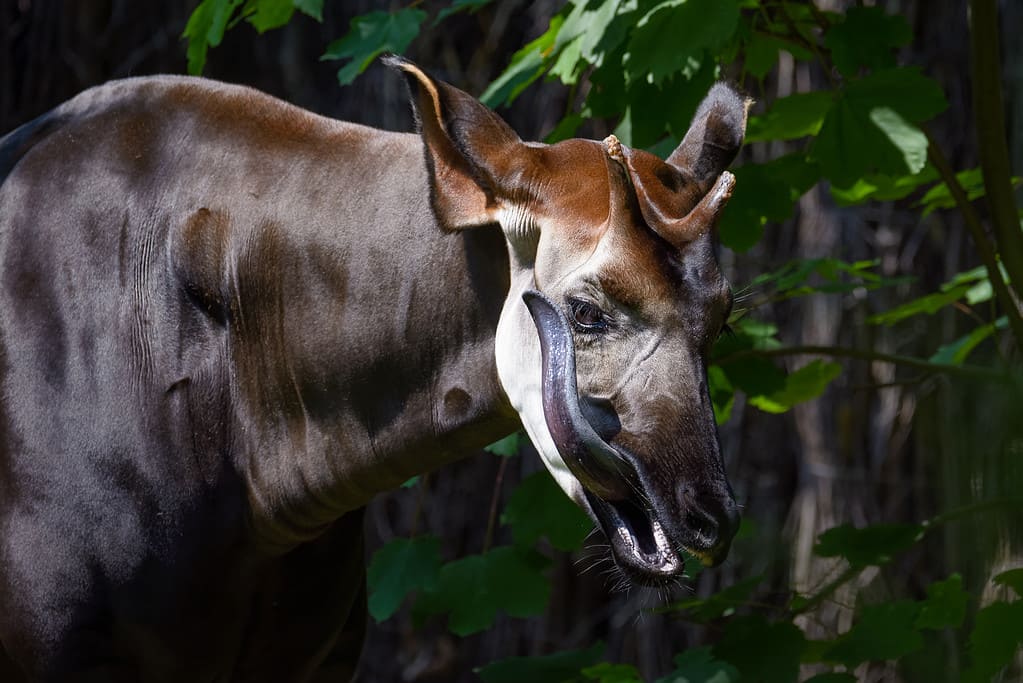
Okapis have ossicones and horns covered in skin, just like giraffes.
©Thorsten Spoerlein/ via Getty Images
The long neck of the okapi enables it to access foliage in lofty trees and bushes. Okapis have ossicones and horns covered in skin, just like giraffes. Only male okapis have ossicones, in contrast to giraffes. Some females have rounded bumps instead of knobs.
7. The Okapi’s Tongue is Extremely Long
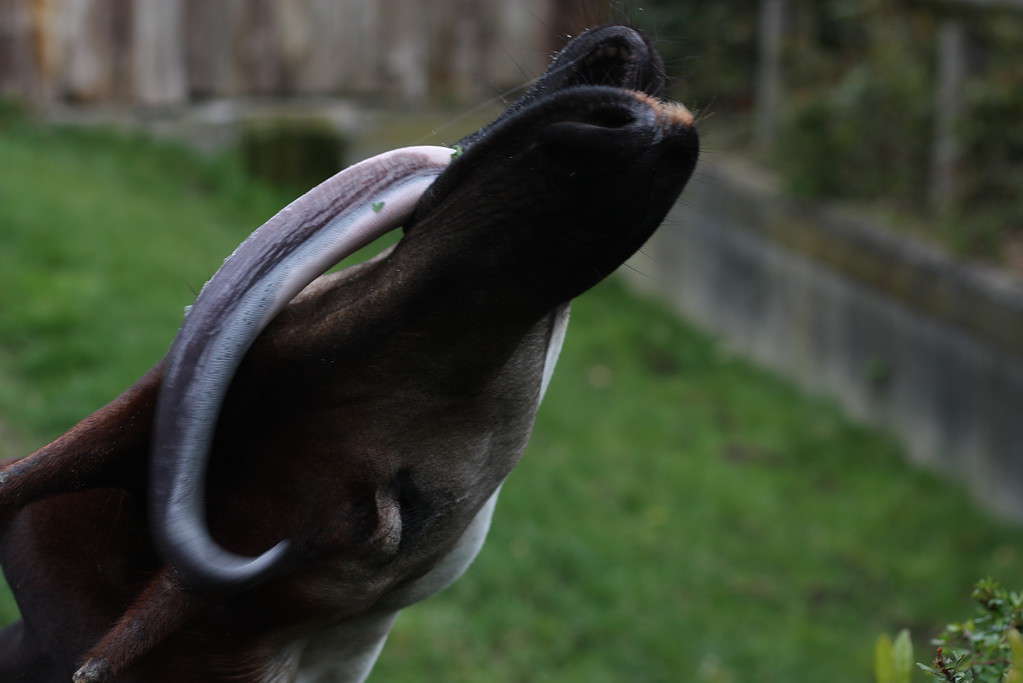
Okapis have a prehensile tongue that can be 12-14 inches long and is used for a multitude of tasks, like washing their eyelids and cleaning their ears.
©kaelin, CC BY-SA 2.0 – License
The tongue of an okapi may reach its eyes and ears!
The prehensile tongue of this animal is long and black. A prehensile tongue has a gripping ability. Food is dragged down to its mouth using it.
8. Okapis Only eat Vegetation

Okapis are herbivores that consume ferns, grasses, fungus, tree leaves, buds, and fruits.
©wrangel/ via Getty Images
Okapis eat only plants. They consume a range of fruits, grasses, fungi, and trees. They are diurnal, i.e., active in the daytime. Okapis are herbivores that consume ferns, grasses, fungus, tree leaves, buds, and fruits. These animals can find food in high branches and bushes, thanks to their long neck.
Okapis have a daily food intake of 18 to 29 kg. As they eat a range of understory vegetation, they significantly impact the ecosystem of their native rainforests. Their large, prehensile tongue, which may measure 12 to 14 inches in length and can wrap around branches to remove foliage, facilitates this task.
9. Okapis are Solitary and Quiet Animals
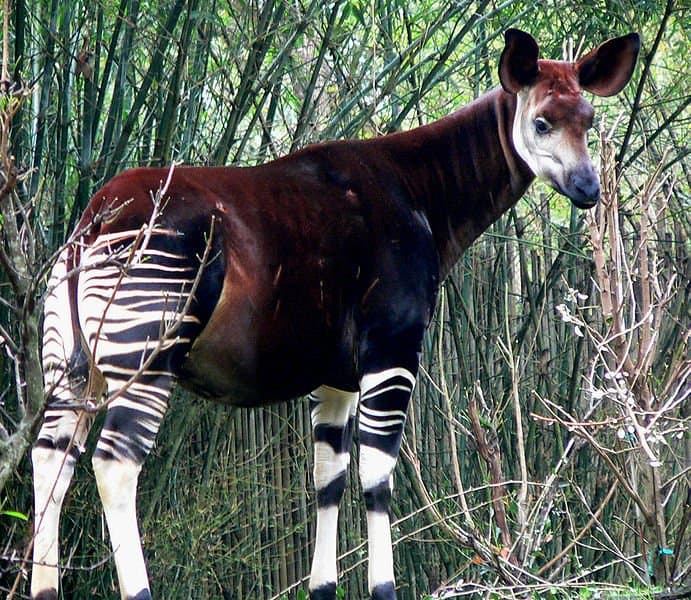
Okapis are solitary creatures who only assemble to mate.
©Raul654 / Creative Commons – License
Okapis produce low-frequency sounds inaudible to humans, and only computer analyses can detect their infrasonic signals. As a covert method of interaction that won’t alert their primary predator, the leopard, these sounds are thought to be employed to enable mother okapis to remain in contact with their offspring while foraging.
Okapis are solitary creatures who only assemble to mate. They can detect the presence of other okapis, thanks to scent glands at the base of their feet and a keen sense of smell.
10. Okapis are Endangered
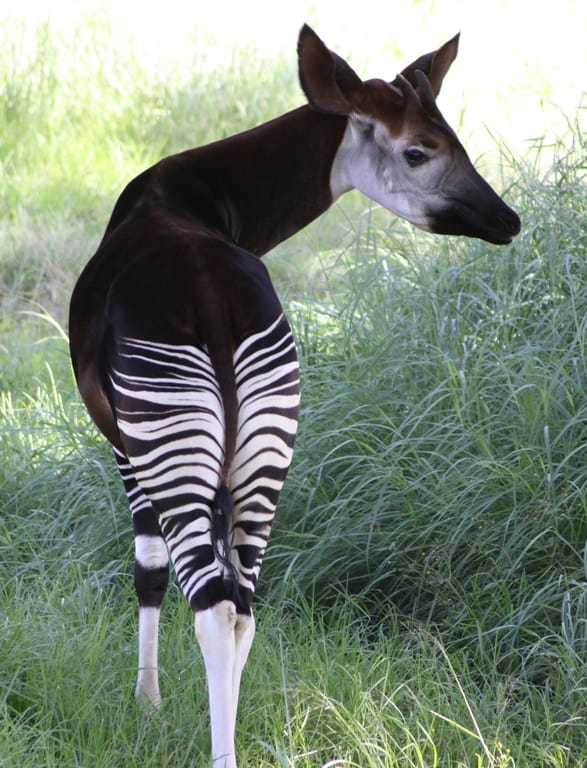
Okapis are threatened by deforestation, as are many other endangered species, and they are poached for their flesh and skins.
©derekkeats, CC BY-SA 2.0 – License
The number of okapis in the wild is estimated to be 25,000, making them an endangered species. Even though this may seem like a lot, you wouldn’t be likely to witness one if you traveled to the Democratic Republic of the Congo.
Okapis are threatened by deforestation, as are many other endangered species, and they are poached for their flesh and skins. Poachers attacked Okapi Wildlife Reserve employees and animals in 2012.
The International Union for the Conservation of Nature (IUCN) has designated okapis as “Endangered.” So, to safeguard the okapi, the Okapi Conservation Project was established.
The photo featured at the top of this post is © seth miles/Shutterstock.com
Thank you for reading! Have some feedback for us? Contact the AZ Animals editorial team.






